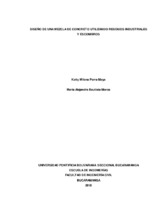| dc.contributor.advisor | Director. Serrano Guzmán, María Fernanda | |
| dc.contributor.author | Parra Maya, Katty Milena | |
| dc.contributor.author | Bautista Moros, María Alejandra | |
| dc.coverage.spatial | Seccional Bucaramanga. Universidad Pontificia Bolivariana. Escuela de Ingenierías. Facultad de Ingeniería Civil | spa |
| dc.coverage.temporal | 2010 | |
| dc.date.accessioned | 2014-01-13T22:05:21Z | |
| dc.date.available | 2014-01-13T22:05:21Z | |
| dc.date.issued | 2014-01-13 | |
| dc.identifier.uri | http://hdl.handle.net/20.500.11912/1358 | |
| dc.description | 115p.: (pdf); il; gráficas, tablas | spa |
| dc.description.abstract | El ejercicio de la construcción genera gran cantidad de escombros. Como una alternativa para mitigar el impacto ambiental generado por estos escombros, seempleó una metodología que permitió el aprovechamiento de residuos industriales inertes como agregados no convencionales en mezclas de concreto. De esta manera, se dosificaron cuatro mezclas con diferentes proporciones de material y tres relaciones agua/cemento (0.4, 0.45, 0.5). La selección de las mezclas de los agregados fue determinada considerando el menor porcentaje de vacios arrojado por dichas mezclas. Un total de 144 especímenes de concreto (dimensiones 30 cm de alto y 15 cm de diámetro, en promedio) fueron preparados manteniendo constante un 10% de escombros y modificando los gruesos y/o los finos, por un 6 y/o 10% de limalla. En el caso de este estudio, los porcentajes asumidos correspondieron a valores de porcentaje de vacíos en mezclas de agregados entre 38,7% y 42,1%. Se observó que la mezcla dosificada con 61% de agregado grueso, 23% de agregado fino, 6% limalla fina y 10% de escombro, presentó los valores más altos de resistencia promedio de los especímenes ensayados 306.74 kg/cm2 lo cual representa un 46% por encima del valor del concreto que se requería (210 kg/cm2). De esta manera, se puede concluir que la adición de limalla y escombros permite un aumento de la resistencia del concreto y un aprovechamiento de dos residuos sólidos provenientes de actividades industriales y a su vez esta reportando un ahorro del 30% con respecto a la produccion de concreto con agregados convencionales. Esto demuestra, que el aprovechamiento de residuos solidos inertes representa genera un beneficio ambiental que conlleva a ahorros para la empresa. | spa |
| dc.description.abstract | Building construction activities produce a lot of solid waste materials, as debris. In this project, an ecological concrete design has been developed to recover debris and use them in the preparation of concrete mixtures.
In that way, four mixtures have been prepared with different proportions of materials, and three water/cement ratio (0.4, 0.45, and 0.5). The selection of the aggregates has been determined by considering the lowest percentage of voids in the aggregates mixture. A total of 144 concrete specimens (dimensions 30 cm high and 15 cm in diameter on average) were prepared with 10% of debris and including 6% and 10% of swarf material, changing the proportion of coarse and fine natural material.
For this study, the lowest percentage of voids values in mixtures of aggregates was between 38.7% and 42.1%. It was observed that using 61% of coarse aggregate, 23% of fine aggregate, 6% of fine swarf and 10% of of debris, shown the highest values of average compression strength (306.74 kg/cm2), representing a 46 % higher than the value of the required concrete (210 kg/cm2).
Thus, it can be concluded that the addition of swarf and debris allow an increase in concrete strength. Moreover, that with these two solid wastes materials it is possible to prepare concrete with 30% of saving, comparing with commercial prices. Finally, it has been shown that the use of inert solid waste generate an alternative to recover and preserve the environment. | |
| dc.language.iso | spa | |
| dc.publisher | Universidad Pontificia Bolivariana | spa |
| dc.rights | Attribution-NonCommercial-NoDerivatives 4.0 International | * |
| dc.rights.uri | http://creativecommons.org/licenses/by-nc-nd/4.0/ | * |
| dc.subject | Residuos industriales | spa |
| dc.subject | Hormigón | spa |
| dc.subject | Construcción | spa |
| dc.subject | Análisis del impacto ambiental | spa |
| dc.subject | Aprovechamiento de residuos | spa |
| dc.subject | Tesis y disertaciones académicas | spa |
| dc.subject | Escombros | spa |
| dc.title | Diseño de una mezcla de concreto utilizando residuos industriales y escombros | spa |
| dc.type | Trabajo de grado | spa |
| dc.rights.accessRights | openAccess | spa |
| dc.type.hasVersion | publishedVersion | spa |
| dc.identifier.instname | instname:Universidad Pontificia Bolivariana | spa |
| dc.identifier.reponame | reponame:Repositorio Institucional de la Universidad Pontificia Bolivariana | spa |
| dc.identifier.repourl | repourl:https://repository.unab.edu.co/ | |


